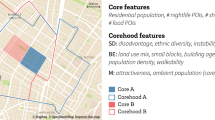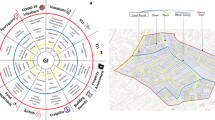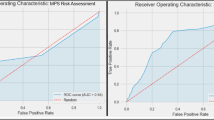Abstract
Policing efforts to thwart crime typically rely on criminal infraction reports, which implicitly manifest a complex relationship between crime, policing and society. As a result, crime prediction and predictive policing have stirred controversy, with the latest artificial intelligence-based algorithms producing limited insight into the social system of crime. Here we show that, while predictive models may enhance state power through criminal surveillance, they also enable surveillance of the state by tracing systemic biases in crime enforcement. We introduce a stochastic inference algorithm that forecasts crime by learning spatio-temporal dependencies from event reports, with a mean area under the receiver operating characteristic curve of ~90% in Chicago for crimes predicted per week within ~1,000 ft. Such predictions enable us to study perturbations of crime patterns that suggest that the response to increased crime is biased by neighbourhood socio-economic status, draining policy resources from socio-economically disadvantaged areas, as demonstrated in eight major US cities.
This is a preview of subscription content, access via your institution
Access options
Access Nature and 54 other Nature Portfolio journals
Get Nature+, our best-value online-access subscription
$29.99 / 30 days
cancel any time
Subscribe to this journal
Receive 12 digital issues and online access to articles
$119.00 per year
only $9.92 per issue
Buy this article
- Purchase on Springer Link
- Instant access to full article PDF
Prices may be subject to local taxes which are calculated during checkout






Similar content being viewed by others
Data availability
Crime incident data used in this study are in the public domain. The web links for the data sources for seven out of the eight cities considered here are: opendata.atlantapd.org, data.austintexas.gov, data.detroitmi.gov, data.lacity.org, www.opendata.philly.org, data.sfgov.org, and data.cityofchicago.org, and for Portland the data along with the leader-board data for the forecasting challenge were obtained from nij.ojp.gov.
Code availability
Software with source code is available at https://github.com/zeroknowledgediscovery/Cynet, and the current version of the software may be referenced by https://doi.org/10.5281/zenodo.5730613. Any questions on implementation should be directed to the corresponding author.
References
Bowers, K. J., Johnson, S. D. & Pease, K. Prospective hot-spotting: the future of crime mapping? Br. J. Criminol. 44, 641–658 (2004).
Chainey, S., Tompson, L. & Uhlig, S. The utility of hotspot mapping for predicting spatial patterns of crime. Secur. J. 21, 4–28 (2008).
Fielding, M. & Jones, V. ‘Disrupting the optimal forager’: predictive risk mapping and domestic burglary reduction in Trafford, Greater Manchester. Int. J. Police Sci. Manage. 14, 30–41 (2012).
Mohler, G. O., Short, M. B., Brantingham, P. J., Schoenberg, F. P. & Tita, G. E. Self-exciting point process modeling of crime. J. Am. Stat. Assoc. 106, 100–108 (2011).
Mohler, G. O. et al. Randomized controlled field trials of predictive policing. J. Am. Stat. Assoc. 110, 1399–1411 (2015).
Poisson, S. D. Probabilité des Jugements en Matiére Criminelle et en Matiére Civile, Précédées des Régles Générales du Calcul des Probabilitiés (Bachelier, 1837).
Du Sautoy, M. The Creativity Code: Art and Innovation in the Age of AI (Harvard Univ. Press, 2020).
Ferdinand, T. N. Demographic shifts and criminality: an inquiry. Br. J. Criminol. 10, 169–175 (1970).
Cohen, L. & Felson, M. Social change and crime rate trends: a routine activity approach. Am. Sociol. Rev. 44, 588–608 (1979).
Cohen, L. E. Modeling crime trends: a criminal opportunity perspective. J. Res. Crime Delinquency 18, 138–164 (1981).
Wang, X. & Brown, D. E. The spatio-temporal modeling for criminal incidents. Secur. Inform. 1, 2 (2012).
Liu, H. & Brown, D. E. Criminal incident prediction using a point-pattern-based density model. 19, 603–622 (2003).
Caplan, J. M., Kennedy, L. W., Barnum, J. D. & Piza, E. L. Crime in context: utilizing risk terrain modeling and conjunctive analysis of case configurations to explore the dynamics of criminogenic behavior settings. J. Contemp. Crim. Justice 33, 133–151 (2017).
Kang, H. W. & Kang, H. B. Prediction of crime occurrence from multi-modal data using deep learning. PLoS ONE 12, e0176244 (2017).
Flaxman, S., Chirico, M., Pereira, P. & Loeffler, C. Scalable high-resolution forecasting of sparse spatiotemporal events with kernel methods: a winning solution to the NIJ ‘real-time crime forecasting challenge’. Ann. Appl. Stat. 13, 2564–2585 (2019).
Mohler, G. & Porter, M. D. Rotational grid, PAI-maximizing crime forecasts. Stat. Anal. Data Min. 11, 227–236 (2018).
Chattopadhyay, I. & Lipson, H. Abductive learning of quantized stochastic processes with probabilistic finite automata. Philos. Trans. R. Soc. A 371, 20110543 (2013).
Mohri, M. Weighted Finite-State Transducer Algorithms. An Overview (Springer, 2004).
Granger, C. W. J. Testing for causality: a personal viewpoint. J. Econ. Dyn. Control 2, 329 – 352 (1980).
Papachristos, A. V. & Bastomski, S. Connected in crime: the enduring effect of neighborhood networks on the spatial patterning of violence. Am. J. Sociol. 124, 517–568 (2018).
Papachristos, A. V., Wildeman, C. & Roberto, E. Tragic, but not random: the social contagion of nonfatal gunshot injuries. Soc. Sci. Med. 125, 139–150 (2015).
Green, B., Horel, T. & Papachristos, A. V. Modeling contagion through social networks to explain and predict gunshot violence in Chicago, 2006 to 2014. JAMA Intern. Med. 177, 326–333 (2017).
Kang, H.-W. & Kang, H.-B. Prediction of crime occurrence from multi-modal data using deep learning. PLoS ONE 12, e0176244 (2017).
Stec, A. & Klabjan, D. Forecasting crime with deep learning. Preprint at https://arxiv.org/abs/1806.01486 (2018).
Hannon, L. Neighborhood residence and assessments of racial profiling using census data. Socius 5, 2378023118818746 (2019).
Meyer, W. B. & Graybill, J. K. The suburban bias of American society? Urban Geogr. 37, 863–882 (2016).
Lipton, M. et al. Why Poor People Stay Poor: a Study of Urban Bias in World Development (Australian National Univ. Press, 1977).
Sternlieb, G. & Jackson, K. T. Crabgrass frontier: the suburbanization of the United States. Political Sci. Q. 101, 493 (1986).
Duany, A., Plater-Zyberk, E. & Speck, J. Suburban nation: the rise of sprawl and the decline of the American dream. Choice Rev. Online 38, 38–1251–38–1251 (2000).
Lazare, D. America’s Undeclared War: What’s Killing Our Cities and How to Stop It (Harcourt, 2001).
Young, I. M. Inclusion and Democracy (Oxford Univ. Press, 2002).
Kaplan, M. S., Crespo, C. J., Huguet, N. & Marks, G. Ethnic/racial homogeneity and sexually transmitted disease: a study of 77 Chicago community areas. Sex. Transm. Dis. 36, 108–111 (2009).
Sherman, L. W., Gartin, P. R. & Buerger, M. E. Hot spots of predatory crime: routine activities and the criminology of place. Criminology 27, 27–56 (1989).
Wooldredge, J. Examining the (ir)relevance of aggregation bias for multilevel studies of neighborhoods and crime with an example comparing census tracts to official neighborhoods in Cincinnati. Criminology 40, 681–710 (2002).
Mears, D. P. & Bhati, A. S. No community is an island: the effects of resource deprivation on urban violence in spatially and socially proximate communities. Criminology 44, 509–548 (2006).
Weisburd, D., Groff, E. R., Yang, S.-M. & Telep, C. W. Criminology of Place (Springer, 2014).
Small, M. L. Four reasons to abandon the idea of ‘the ghetto’. City Community 7, 389–398 (2008).
Baumgarten, M. Ghetto: the invention of a place, the history of an idea. Jew. Q. 63, 62–63 (2016).
Heaven, W. D. Predictive policing algorithms are racist. They need to be dismantled. MIT ZTechnol. Rev. 17, 2020 (2020).
Brayne, S. & Christin, A. Technologies of crime prediction: the reception of algorithms in policing and criminal courts. Social Problems 68, 608–624 (2020).
St. Louis, S. & Greene, J. R. Social context in police legitimacy: giving meaning to police/community contacts. Policing Soc. 30, 656–673 (2020).
Weisburd, D. Place-based policing. Ideas in American Policing 9, 1–16 (2008).
Kushnick, L. ‘Over policed and under protected’: Stephen lawrence, institutional and police practices. Sociol. Res. Online 4, 156–166 (1999).
Clifford, R. S. Juvenile delinquency and urban areas: a study of rates of delinquents in relation to differential characteristics of local communities in American cities. Am. J. Sociol. 49, 100–101 (1943).
Sampson, R. J., Raudenbush, S. W. & Earls, F. Neighborhoods and violent crime: a multilevel study of collective efficacy. Science 277, 918–924 (1997).
Miethe, T. D., Hughes, M. & McDowall, D. Social change and crime rates: an evaluation of alternative theoretical approaches. Soc. Forces 70, 165–185 (1991).
Braga, A. A. & Clarke, R. V. Explaining high-risk concentrations of crime in the city: social disorganization, crime opportunities, and important next steps. J. Rs. Crime Delinquency 51, 480–498 (2014).
Silver, D. & Clark, T. Scenescapes: How Qualities of Place Shape Social Life (Univ. of Chicago Press, 2016).
Nathan, R. P. & Adams, C. F. Four perspectives on urban hardship. Political Sci. Q. 104, 483–508 (1989).
Granger, C. W. J. Testing for causality. J. Econ. Dyn. Control 2, 329–352 (1980).
Montero-Manso, P. & Hyndman, R. J. Principles and algorithms for forecasting groups of time series: locality and globality. Int. J. Forecast. 37, 1632–1653 (2021).
Seabold, S. & Perktold, J. Statsmodels: econometric and statistical modeling with Python. In Proc. 9th Python in Science Conference https://conference.scipy.org/proceedings/scipy2010/pdfs/seabold.pdf (2010).
Laxy, M., Malecki, K. C., Givens, M. L., Walsh, M. C. & Nieto, F. J. The association between neighborhood economic hardship, the retail food environment, fast food intake, and obesity: findings from the Survey of the Health of Wisconsin. BMC Public Health 15, 1–10 (2015).
Acknowledgements
Our work greatly benefited from discussion of everyone who participated in our workshop series on crime prediction at the Neubauer Collegium for culture and society (https://neubauercollegium.uchicago.edu/events/uc/crimes_of_prediction_workshop/), and with those with whom we had extended conversations to ground and refine our modelling approach.
Data were provided by the City of Chicago data portal at https://data.cityofchicago.org. The City of Chicago (‘City’) voluntarily provides the data on this website as a service to the public. The City makes no warranty, representation, or guarantee as to the content, accuracy, timeliness, or completeness of any of the data provided at this website (https://www.chicago.gov/city/en/narr/foia/data_disclaimer.html), and the authors of this study are solely responsible for the opinions and conclusions expressed in this study. Sources of the crime incidence data for the other cities are tabulated in Table 1. Socio-economic data for metropolitan areas were obtained from https://www.census.gov.
This work is funded in part by the Defense Sciences Office of the Defense Advanced Research Projects Agency projects HR00111890043/P00004 and W911NF2010302, and the Neubauer Collegium for Culture and Society through the Faculty Initiated Research Program 2017. The claims made in this study do not necessarily reflect the position or the policy of the sponsors, and no official endorsement should be inferred.
Author information
Authors and Affiliations
Contributions
Y.H. and I.C. worked out key mathematical details of the Granger network framework. V.R., T.L., Y.H. and I.C. implemented the algorithms and generated results. Y.H., V.R. and T.L. contributed equally in realizing the current implementation of the software. I.C. generated the visualizations in this study. J.E. provided key insights into modelling and interpreting social dynamics. J.E. and I.C. conceived and designed the research, and wrote the paper.
Corresponding author
Ethics declarations
Competing interests
The authors declare no competing interests.
Peer review
Peer review information
Nature Human Behaviour thanks the anonymous reviewers for their contribution to the peer review of this work.
Additional information
Publisher’s note Springer Nature remains neutral with regard to jurisdictional claims in published maps and institutional affiliations.
Extended data
Extended Data Fig. 1 Out of Sample Predictive Performance over the Years.
We show that the predictive performance is very stable, and variation in mean AUC is limited to the third place of decimal, at least when analyzing the last few years (4 years shown).
Extended Data Fig. 2 Comparison of Predicted vs Actual Sample Paths in Time and Frequency Domains.
Panels a, c and e show that the predicted and actual sample paths are pretty close for different years, when compared over the first 150 days of each year. Panels b, d and f show that the Fourier coefficients match up pretty well as well. More importantly, while our models do not explicitly incorporate any periodic elements that are being tuned, we still manage to capture the weekly, (approximately) biweekly and longer periodic regularities.
Extended Data Fig. 3 Perturbation Effects Across Variables.
We see that the decrease of violent crimes from increase of property crimes are localized in disadvantaged neighborhoods (panel g). Similarly, the decrease of property crimes from increase of violent crimes is also localized to disadvantaged neighborhoods (panel a), as well as the decreased violent crimes from increased arrests (panel k). We see a weaker localization for the corresponding increases in crime rates under similar perturbations. Looking at other pairs of variables under perturbation (rest of the panels), we generally do not see a very prominent correspondence with the distribution of socio-economic indicators. It seems crimes (and particularly violent crimes) are easier to dampen in locales with high existing crime rates, which is desirable result. But such conclusions are currently confounded by SES variables, and further work is needed to investigate these effects more thoroughly.
Extended Data Fig. 6 Automatic Neighborhood Decomposition Using Event Predictability.
Using Event Predictability Computing a bi-clustering on the source-vs-target influence matrix (panel A) isolates a set of spatial tiles that are, on average, good predictors for all other tiles. Using this set, we use a Voronoi decomposition of the city (Panel B), which realizes an automatic spatial decomposition of the urban space, driven by event predictability.
Supplementary information
Supplementary information
Supplementary Fig. 1 and methods.
Rights and permissions
About this article
Cite this article
Rotaru, V., Huang, Y., Li, T. et al. Event-level prediction of urban crime reveals a signature of enforcement bias in US cities. Nat Hum Behav 6, 1056–1068 (2022). https://doi.org/10.1038/s41562-022-01372-0
Received:
Accepted:
Published:
Issue Date:
DOI: https://doi.org/10.1038/s41562-022-01372-0
This article is cited by
-
The promises and perils of crime prediction
Nature Human Behaviour (2022)



